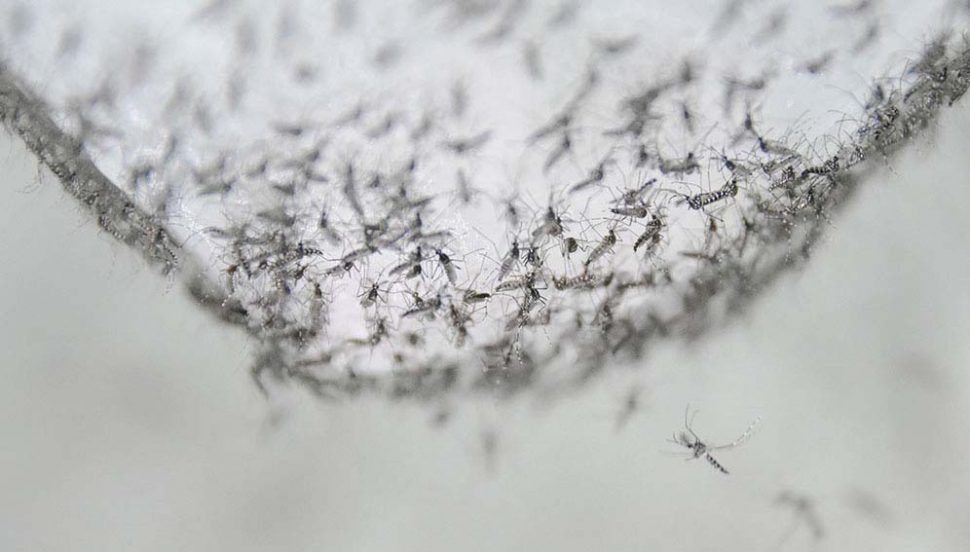By: Michelle Z. Donahue
(SciDev.Net) Scientists say they have almost eradicated populations of the world’s most invasive mosquito species from two test sites in China using a novel two-pronged approach which renders the insects infertile.
During two years of trials on two islands in the city of Guangzhou, researchers reduced the number of viable eggs produced by female Asian tiger mosquitoes (Aedes albopictus) – a major vector for dengue and the Zika virus – by more than 94%.
The international team from Michigan State University (MSU) and Sun Yat-sen University reported a corresponding plunge in adult females, which transmit the disease to humans by biting. Their numbers fell by 83% in 2016 and 94% in 2017.
The breakthrough was achieved by combining two conventional methods of biological engineering for maximum effect.
Zhiyong Xi, molecular geneticist at MSU and lead researcher of the team that published the study in the journal Nature, infected millions of factory-reared male mosquitoes with Wolbachia, a type of bacteria found in insect guts. When these males mate with uninfected wild females, the resulting eggs are sterile. The bacterium itself also suppresses the mosquitoes’ ability to transmit a virus.
Researchers also irradiated each batch of mosquitoes to sterilise any females left in the mix, because releasing Wolbachia-infected females has been shown to undermine the technique.
Considered a “neglected tropical disease” by the World Health Organization (WHO), dengue is spread by the females of the Aedes genus; this includes the species albopictus mosquito, or Asian tiger mosquito. WHO reports that the disease, once relatively obscure, is on the rise: an estimated 390 million cases of dengue occur worldwide per year, with 96 million reporting symptoms that include high fever, joint pain, severe vomiting and respiratory distress.
Warming global temperatures are facilitating the spread of the vector mosquitoes into new areas, or increasing incidence of the disease where it is already present. This includes China, where a 2014 outbreak in Guangzhou lasted 193 days, affecting more than 37,000 people and claiming five lives.
“We have generated a situation no one has reached before,” Xi said. “Now, we can eliminate nearly all mosquitoes in an area, which further allows us to see where they are coming in, how quickly, and determine the minimal release we can maintain to continue that elimination.”
The team also published an analysis of estimated costs for larger-scale deployment of the method, quoting US$108 per hectare per year. This includes the ongoing re-treatment of areas that had already been subjected to an initial period of intensive releases to crush high mosquito populations. He pointed to a similar programme for control of Mediterranean fruit fly in Florida and California, using sterile insects produced in Guatemala, that has been ongoing since 2000.
But Xi did acknowledge that applying the technique in populated areas will be a challenge, as the movement of people in and out of an area would facilitate an easier return of mosquitoes back into a previously treated area.
“In cities, we’ll look for wide roads or highways and use these as barriers to generate relatively isolated areas for treatment,” Xi told SciDev.Net. “But human activity does present a challenge for using this tool in [an] urban setting.”
Peter Armbruster, an expert in container-breeding mosquitoes with Georgetown University in Washington DC, wrote in an analysis that despite the study’s “remarkable” results, many questions remain about the long-term sustainability of the approach.
“Efforts to develop automated release technologies … should substantially improve production and release capacity,” Armbruster wrote in Nature. “However, whether such technological advances can overcome the financial and logistical challenges of implementing these approaches at a scale that reduces disease transmission across a major metropolitan area or nationwide remains to be seen.”
Xi said that the next phase of research will involve drone releases of modified mosquitoes at high-rise apartments in economically depressed areas of Guangzhou — structures with high dengue prevalence — to test the viability of automated methods that could cover larger territories.
Reproduced from SciDev.Net: https://bit.ly/32ZE5yO









